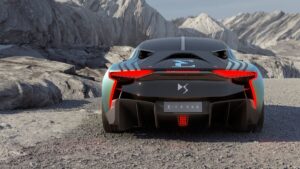Parisian luxury carmaker DS Automobiles has developed a prototype electric vehicle (EV) that uses only electric motor regeneration instead of conventional brakes, showcasing a potential future on EVs.
Using technology from the brand’s Formula E race car, the DS E TENSE PERFORMANCE uses two onboard electric motors to slow the vehicle entirely through regenerative braking, up to 600 kW.

Though regenerative braking is already available in most EVs, the technology is currently used to complement conventional friction brakes. However, DS is exploring whether regenerative braking alone could eventually be the sole method to slow cars down, helping to better recharge the battery in the process and doing away with conventional brake discs and pads. The intelligent technology renders the conventional Formula E braking system fitted to the DS E TENSE PERFORMANCE completely redundant.
Sign-up to Electric Road now to receive a FREE ‘Guide to the Best Electric Cars’, a weekly Newsletter and to win some great prizes!
The DS E TENSE PERFORMANCE has been developed in conjunction with the brand’s championship winning Formula E team and uses the same motors that can be found in the electric race cars. With 815hp on tap and 8,000Nm of torque, the DS E TENSE PERFORMANCE can accelerate from 0-62mph in just two seconds. Using 350kW charging, a full charge can be completed in just five minutes.

Beatrice Foucher, DS Automobiles CEO said: “Formula E is about maximising performance and efficiency and the DS E TENSE PERFORMANCE is our vision of a road car utilising our race-winning technology. Regenerative braking is a very powerful way to not only slow the vehicle down but also help improve battery performance. The DS E TENSE PERFORMANCE takes the technology to a new level, with regenerative braking used solely to slow the vehicle down.”










